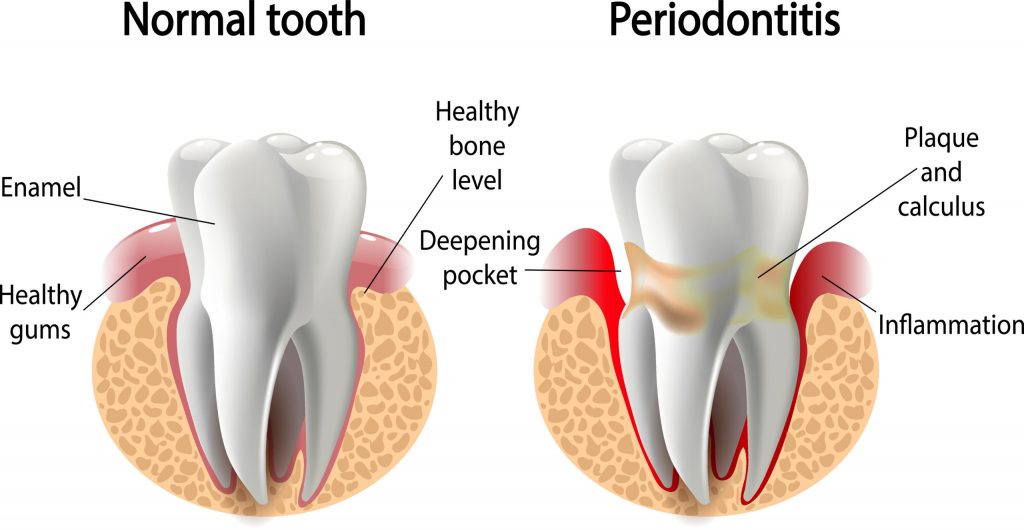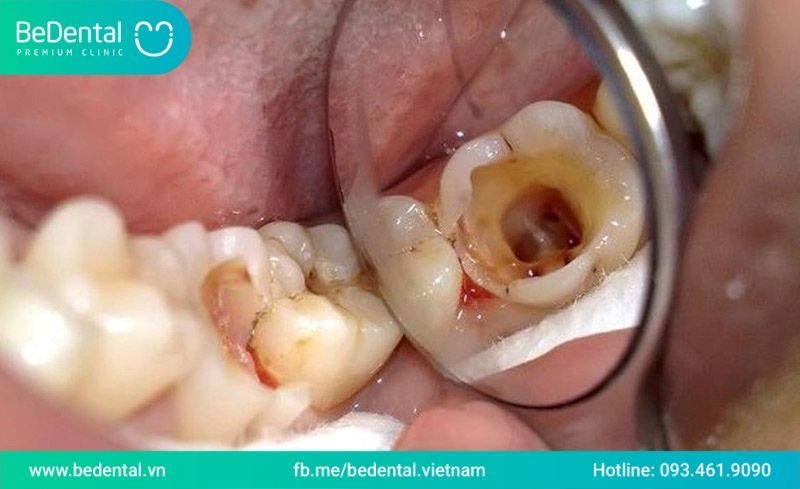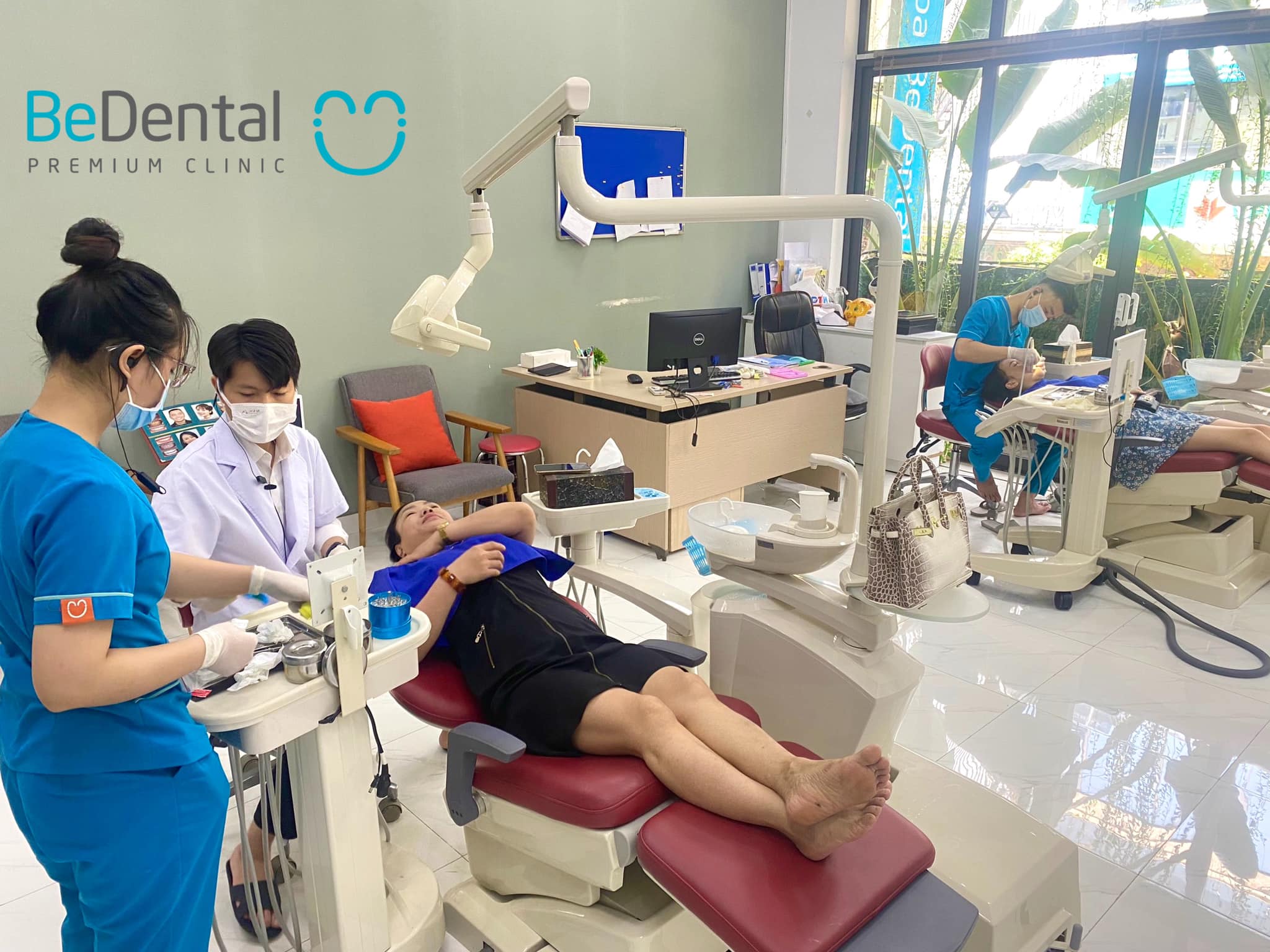Infected gums with pus are a sign of localized or spreading infection within the mouth. It is a serious oral health issue that can lead to unpredictable complications if left untreated.
What is an infected gum with pus?
A tooth consists of an outer layer called enamel, an inner layer called dentin, and within the tooth, there is a chamber containing soft tissue, including blood vessels, nerves, and connective tissue, known as the dental pulp. Blood vessels and nerves enter the tooth through openings at the root of the tooth. This area is called the tooth socket.
The tooth socket is the part of the tooth that cannot be seen in the mouth because it is located within the bony socket called the alveolar bone. The outermost layer covering the alveolar bone is the gum, also known as the gingiva.
Infected gums with pus occur when bacteria attack the dental pulp or the gum tissue, leading to infection and the formation of abscesses in the tooth socket, around the tooth root, or in the gum tissue. If not treated promptly, the infected gums can cause severe oral health problems and even have serious implications for overall health, including life-threatening complications.

Causes of infected gums with pus
There are two main causes of the condition known as dental abscess, which include:
Periodontal disease (gum disease)
Poor oral hygiene, food debris trapped between teeth, deep-seated gum pockets that cannot be cleaned, irregular dental cleaning (removal of dental calculus), sharp objects piercing the gums, such as toothpicks, are causes of gum inflammation. When the gums are inflamed, you may experience bad breath, gums that easily bleed when brushing or spontaneously, swollen and red gums that cover part of the tooth.
If gum inflammation is not treated promptly, the gums will bleed more, and food debris trapped between teeth will provide favorable conditions for bacterial growth, leading to gum infection. At this stage, there will be pus at the tooth socket, destruction of the bone surrounding the tooth, gum recession, causing tooth mobility. In this case, the disease progresses from gum inflammation to dental abscess.
If dental abscess is not treated early and regularly, it can result in the loss of multiple teeth, seriously affecting our oral health.

Diseases of the dental pulp
Your teeth can become decayed due to trauma or infection around the tooth that spreads over time to the dental pulp inside. Bacteria from tooth decay invade the dental pulp, causing a large cavity that allows direct contact between the dental pulp and the oral environment, resulting in infection and death of the pulp.
If left untreated, dental pulp inflammation can lead to deep infection in the tooth socket, causing pressure and swelling. This is a severe stage of the disease.
If the tooth infection is not treated, over time, the infection can spread throughout the tooth and even to other roots. Eventually, it can spread to the gums surrounding the tooth, causing jaw bone destruction and loosening of the affected tooth, which may require extraction.
The most dangerous aspect is that the bacteria in the pus pocket can enter the bloodstream, leading to life-threatening bloodstream infections.
Certain conditions such as misaligned teeth, malocclusion, medication use, endocrine disorders, diabetes, and weakened immune system can also contribute to the development of infected gums with pus.
Signs of infected gums with pus
A common symptom of gum inflammation is tooth pain. The pain can radiate throughout the jaw, ear, and neck. The pain worsens when eating or chewing, or when pressure is applied to the affected tooth.
The gum at the base of the tooth is swollen, soft, red, and painful when pressed. The affected side of the face may be swollen, with red and warm skin. The affected tooth may be sensitive, with a throbbing sensation or a dull ache, and may change color.
Do dental crowns require anesthesia? The process of getting dental crowns with anesthesia
At this point, there may also be swollen lymph nodes under the jaw and in the neck. There may be pain when pressing on the lymph nodes, along with fever and bad breath. When a large amount of pus is released, you may not feel any pain. There may be raised bumps at the tooth socket, and pus may be discharged when pressed. You may not feel pain because the pus from the tooth socket drains through a tunnel from the pus pocket in the tooth socket to the gums.
The gums may be swollen, soft, red, painful when pressed, prone to bleeding, and sometimes have pus around the gumline surrounding the tooth.

How to effectively treat infected gums?
The best way to completely treat infected gums with pus is to see a dentist as soon as possible. At that time, the dentist will conduct a thorough examination, provide an accurate diagnosis, and determine the targeted treatment method for each different condition.
The principles of treating infected gums with pus are:
- Isolate the infected area with antibiotics.
- Remove or reduce uncomfortable symptoms, such as pain, fever, swelling…
- Eliminate the source of infection: When the infection is stable and safe for surgery, the dentist will perform a surgical procedure to remove the infected area.

Procedures for removing inflamed and infected abscesses include:
- Incision and drainage (abscess drainage): The dentist will make a small incision in the swollen area with pus to drain the pus out.
- If there are foreign objects such as bones or splinters, they will be removed from the gum.
- Treatment of periodontal inflammation: Scaling the teeth, removing any plaque or debris around the tooth and below the gumline.
- Root canal treatment: The dentist will remove the infected pulp from the tooth and clean and seal the root canal before filling and crowning the tooth.
- Crown lengthening: The dentist will perform a minor surgical procedure to remove infection from the tooth crown.
- Tooth extraction: When the infection is severe and the tooth is severely damaged and cannot be saved, tooth extraction is necessary. The dentist will extract the tooth and clean the infected area deep within the bone. After successful extraction, a dental prosthesis will be made once the wound has healed.
- Sometimes, severe inflammation and infection can form a large cyst in the bone that spreads to other teeth, causing widespread damage. Treatment is not limited to addressing the underlying cause and may require removal of all cysts and treatment or extraction of related teeth. In such cases, treatment becomes much more complex and sometimes irreversible.
- Removing underlying causes such as correcting bite alignment, orthodontic treatment, adjusting or changing systemic medications, and maintaining good blood sugar control are also important.
What is Amalgam Dental Filling? 4 Advantages of Amalgam Dental Filling

How to prevent infected gums with pus?
How to prevent infected gums with pus ? You should take care of your oral hygiene daily by brushing your teeth properly at least twice a day, using dental floss or interdental brushes to remove food debris stuck between teeth, and using mouthwash after meals to maintain oral hygiene.
Choose a suitable diet for your teeth. Limit foods high in sugar or acid. Supplement calcium and vitamins from whole foods such as eggs, beans, milk, mushrooms, which are good for your teeth.
Avoid foods that are too hot, too cold, or too spicy, as they can damage the teeth.

You should visit the dentist every 6 months for teeth cleaning. If any dental issues are detected, they will be examined and treated promptly. When infected gums with pus are detected, you should seek dental examination and the dentist will provide thorough and effective treatment.
Dental experts at Bedental are equipped with the KAVO dental chair system (Germany), intraoral cameras, Gendex panoramic machine, in-office dental X-ray machine, Gendex phosphor plate scanner, Dently ultrasonic scaler, Radii Plus Australia teeth whitening machine, endodontic equipment, and root canal measurement devices, which maximize support in dental examinations and procedures.
Moreover, Bedental has a team of skilled doctors with extensive expertise and experience in the field of Dentistry.
If you have any questions or inquiries related to dental issues such as wisdom tooth extraction cost, does braces hurt, how much does teeth whitening cost, etc., please contact us through
How to Stop Bleeding after Wisdom Tooth Extraction? Some Ways to Control Bleeding
Tư vấn chuyên môn bài viết:
BÁC SĨ ĐÀM TRỌNG HIẾU
BEDENTAL - TOP STANDARD DENTISTRY SYSTEM
In HANOI
Address 1: 7B Thi Sach St, Ngo Thi Nham, Hai Ba Trung Dist, Ha Noi. - 0934.61.9090
Address 2: No 129 Hoang Ngan, Yen Hoa, Cau Giay Dist, Ha Noi. - 0934.61.9090
In HO CHI MINH
Address 1: 53 -55 -57 Pho Duc Chinh St, Nguyen Thai Binh, Dist. 1, Ho Chi Minh. - 0766.00.8080
Working: 9am - 8pm everyday
Website: https://bedental.vn/en/
PLEASE LEAVE YOUR INFORMATION IF YOU REQUIRE FURTHER CONSULATION





